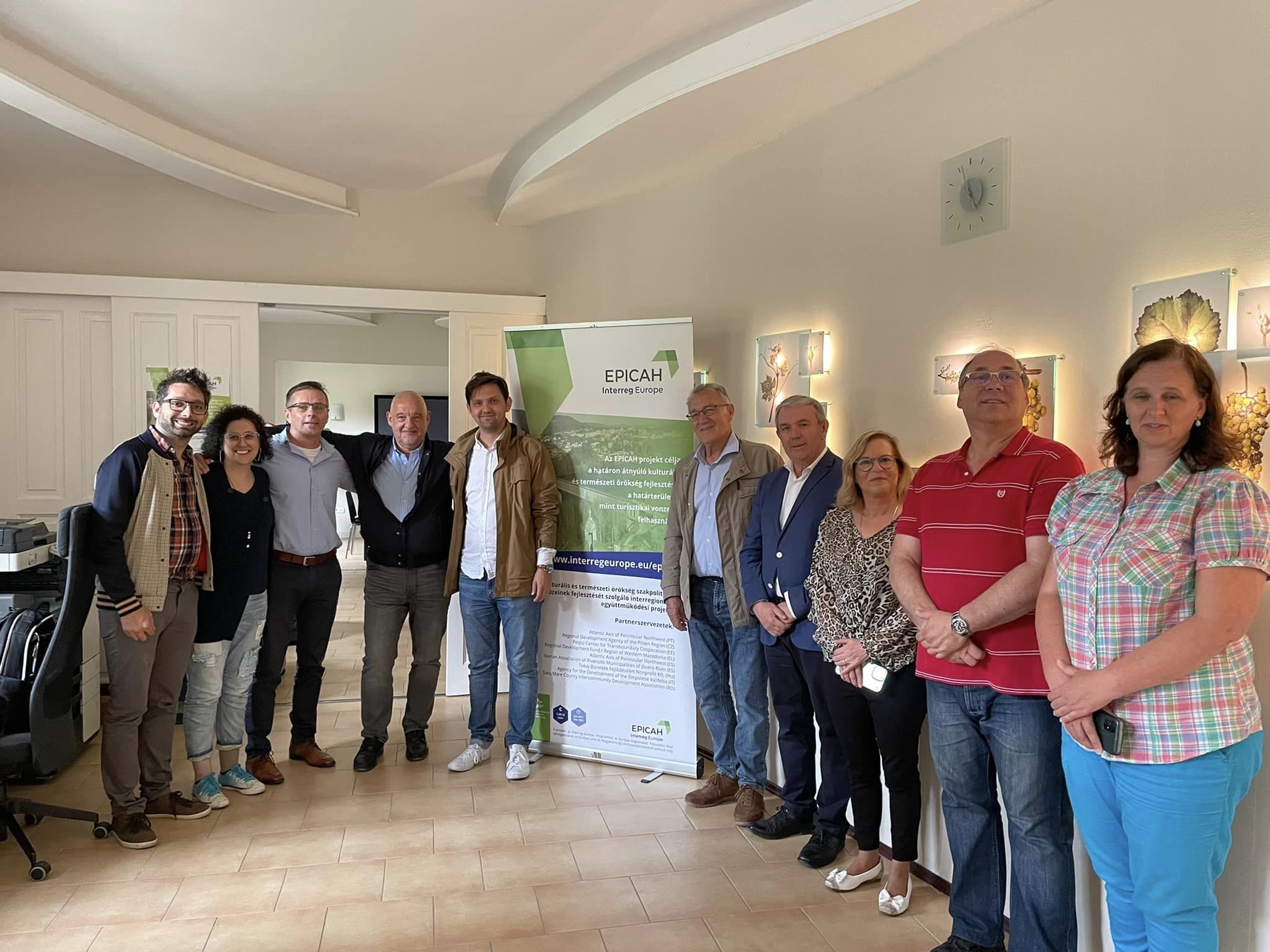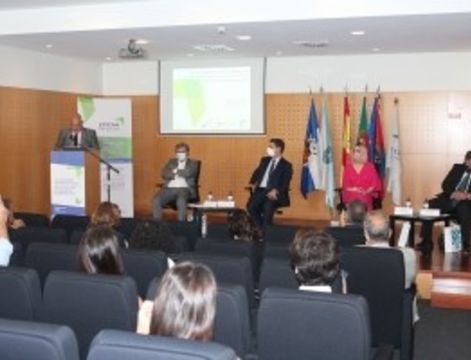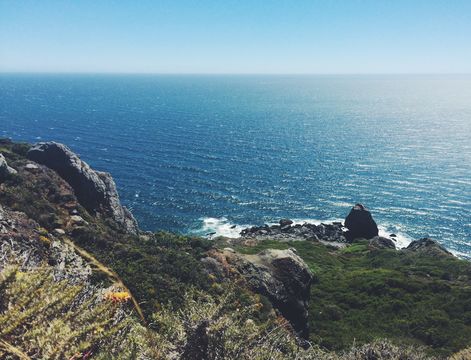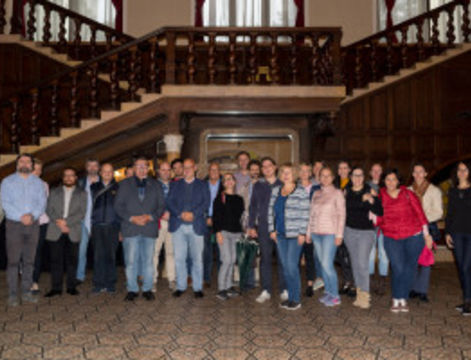
Impact of the COVID19 pandemic meeting
Meeting: Impact and recovery of the COVID 19 pandemic
EPICAH aims to promote the improvement of the policy instruments for crossborder cooperation processes in the natural and cultural heritage protection. The objective of the project is also to develop the management of the border by using it as a tourist attraction factor. It shall improve the effectiveness of tourism activity in managing the organization and valorisation of these assets.
For the next five years partners will learn from each other and share their knowledge and also their challenges they face in crossborder development in order to enhance the cooperation between border entities by encouraging coordinated actions of the policy makers and technicians responsible for its implementation by developing sustainable, homogeneous and consistent tools on both sides of the border in heritage preservation.
Connected by borders.
The partners various cultural and natural resources situated in border areas like forests, sea, monuments, rivers or vineyards, calls for a particular focus on the collaboration between local stakeholders in order to carry out actions for a common goal: nature conservation and preservation of cultural heritage by making accessible for tourism in a sustainable approach.
€1,931,295.00
Environment and resource efficiency
The important factor of the learning process are the thematic seminars and the study visits where partners exchange and develop tools to implement in the regions. In addition, each partner set up a Regional Stakeholder Group that gives feedback about the implementation of the working tools.
The combination of the work of each partner entities as well as the implication and feedback of the stakeholder group will serve to overcome conflict, misunderstood and lack of cooperation through the suggestion of new types of projects in the current crossborder programmes or even by proposing a new logical framework of the Interreg A programmes for the next programming period.
In each region the border fragmentises and divides organically cohesive cultural landscape with varied and symbiotic communities and heritage that have been existing and developing together for centuries. Through the project’s implementation the stakeholders from the two sides of the border rediscover and experience the benefits and catalysation effects of cooperation, practice and knowledge sharing. An appalling project could affect the region’s crossborder cooperation networks’ further development and enhancement with newly joining cultural and economic entities that could revitalize the organic and prosperous interconnections of the region. It could also be a good tool to eliminate the conflict of interests between the two sides of the border and make the benefits of cooperation visible.
Interreg A POCTEP is running since 1989. Among years, it has evolved from a program for parallel actions to a program that promotes real joint activities and from prioritizing infrastructure to bet for immaterial assets like culture, environment, innovation, health or culture. The final aim of POCTEP is to improve the quality of life of people living in border areas.
EPICAH will address POCTEP 2014-2020 focusing on priority 3 (of 5) “Protect the environment and promote the efficiency in the use of local resources”. Within this priority, on the objective of “protect and valorise cultural and natural heritage as a resource for economic development in the border area”.
To approach to the above-mentioned objective, the program foresees actions to deploy the potential of the tourism sector in the natural areas and for the protection and promotion of culture and natural heritage as economic assets. In this sense, it boosts activities like networks creation, coordinated management of assets, studies or creation of common brands for joint promotion.
This approach seems good but not enough to release the full potential of cultural and natural heritage contribution to the economic development. To achieve this ambitious objective, it is needed to design and implement common (not only coordinated) strategies in the crossborder regions, having as a result the joint development of these resources, being worked out on both sides of the border as if the border would not exist.
The objective of the programme is to «Foster a smart, sustainable and inclusive growth in the cross-border area» which aims to prioritize the «Support to the development of green and blue economies» [Axis 1] and by «Enhancing and protecting the natural and cultural heritage» [Axis 2]. This 2 priority axes include several thematic objectives, like:
TO3- Improve SME competitiveness, particularly referring to blue and green economies (including tourism)
TO6 – Preserve and protect the environment and promote efficient use of resources In this context, the programme measures are addressed to SMEs (mainly cluster of SMEs), institutions, universities, public-private research centres and associations. These measures will help respond to many territorial needs and also increase awareness about green and sustainable business models along the whole value chain of tourism sector, particular referring to cross border value chains, strengthening local policy instruments for the reduction of pressure on environment and preservation of natural and cultural heritage by giving it a crossborder approach.
Barriers are represented by a high fragmentation of the tourism system (high % of micro enterprises and stakeholders) that slows the access to green and sustainable business models and technologies and by a low propensity of local administration to deal with high scale problems (environment, tourism flows and mobility) with integrate policies at transnational level.
Region of Western Macedonia (RWM) will prepare a RAP for axis 6 of the ROP structural funds that will combine the project objectives & interregional lessons learnt with RWM natural & cultural heritage policy. The main objective of the ROP–Investment priority 6.c is to focus on supporting the regional heritage policy on economic & social dimensions, including tourism actions in the cross border areas with Albania & FYROM. The main characteristics of the specific RAP as an outcome of the project, includes activities to promote the economic attractiveness of the regional economy through its unique natural beauty & cultural heritage. The priority among cross border-territories & other actions of the specific policy instrument 6.c chosen is high.
RWM needs to follow alternative development models since it faces many difficulties coming out of the remaining financial crisis, the market globalization & the environmental problems because of the mining activities of the Greek PPC in the region since 1950. Natural & heritage related aspects connected with agro-tourism consist increasingly a key factor for sustained economic development for RWM, that’s why the related policy instrument should be improved. Partners’ best practices will add European level value to this effort. It is the first time that this ROP policy instrument will be implemented in a large-scale policy level in RWM, along with the experience coming out of former cross border projects, in regional and European level.
The programme addresses some of the important crossborder challenges which are linked to the implementation of Europe 2020 in the Estonia-Latvia border.
A strong focus of the programme is on environmental measures. It will support natural & cultural heritage in order to further develop sustainable tourism in the region, and will support the promotion of more environment-friendly behaviour of the population.
The cooperation programme will promote entrepreneurship, facilitate the economic exploitation of new ideas and foster the creation of new firms. It will also help SMEs to engage in innovation processes, and will support crossborder labour mobility.
It has four priorities an EPICAH will address (under the priority 2) the objective 2.1 “More diversified and sustainable use of natural and cultural heritage”
The programme addresses the most important crossborder challenges that are linked to the implementation of the Europe 2020 strategy in the Bavarian-Czech border region. Strategically, the programme promotes a better integration of research and development capacities on both sides of the border to exploit the full economic potential of the region. At the same time, it addresses environmental issues, in particular bio-diversity, & (increasing) challenges linked to climate change. It also protects and promotes cultural and natural heritage. Actions will be complemented by efforts to foster closer cooperation in legal and administrative questions, in order to create a fully integrated border region. To achieve these strategic objectives, the programme aims to raise the nº of crossborder business and research networks, to increase the bio-diversity, to promote the joint cultural & natural heritage, to intensify investment in education & training, and to further improve crossborder governance structure.
Priority of the programme addressed by the project: Conserving & protecting the environment & promoting resource efficiency (cultural & natural heritage)
Involved Regions: CZ–Pilsen Region, South Bohemia Region, Karlovy Vary Region & DE–Niederbayern, Oberpfalz, Oberfranken
The most significant problem related to the programme efficiency is the lack of real intensive linkages at the institutional & personal levels. It should power methodical support for networking across the border
Interreg V-A Romania Hungary Programme, which shall be implemented in the period 2014-2020, continues the financing of cooperation in the Romanian-Hungarian border area, realized in the period 2007-2013 through the Hungary-Romania CBC Programme.
The Romania-Hungary Programme addresses, in priority axis 1, the joint protection and efficient use of common values and resources. Under thematic objective 6c, support can be provided to complex interventions, including the rehabilitation of various natural, cultural and historic values, as well as to facilitate contributing to the protection of the joint natural, cultural and historical heritage on both sides of the border. Support can also be provided to creating competitive thematic routes for the rehabilitated values and facilities, as well as to the promotion of these routes and to improving their accessibility.
While in the previous financial period, actions in the field of natural and cultural heritage have been rather parallel than integrated, the new programme intends to support actions which lead to crossborder results and effects. This intention, together with the large diversity of actions to be supported, is good but needs to be supplemented with real common strategies through which the natural and cultural potential contributes to the development of tourist activities that lead to the economic development and territorial competitiveness of border areas.
The programme aims at the joint protection, development & touristic utilization of the border regions' common natural & cultural heritage
The Programme will focus on 4 main priorities and EPICAH will address the 1st one: Nature and Culture
Under this priority axis the following results are sought to be achieved:
-Better utilization of the regions endogenous natural and cultural potential in supporting the sustainable development of local economies
-Increasing social, economic and territorial cohesion by supporting joint cultural activities and activities concerning to nature preserving and protection
-Improving social, economic and territorial cohesion by supporting joint cultural and nature conservation activities
-Increasing the number of visitors in the programme area
One of its main characteristics are continuous support for the cooperation of public institutions and communities living next to each other on either two sides of the border. The HU-SK border divides many organically cohesive cultural landscapes. The integration of these cultural landscapes already started thanks e.g. to the cooperation of national parks, joint cultural events or the development of thematic tourist paths through earlier CBC programmes. But further integration of the regions natural and cultural environment is fundamental in order to foster sustainable development and to avoid the establishment of parallel capacities, and to promote cooperation instead of competition.

Meeting: Impact and recovery of the COVID 19 pandemic
Reporting from the CZ-BY cross-border cooperation – Interreg Europe EPICAH project
The Regional Development Fund of Western Macedonia organizes an interesting online seminar on Monday 4 Apr 2022, at 09.00 am CET.

The Interreg Europe Policy Learning Platform continues "on the road" and made a stop in the Portuguese regions at an online event on 19 October attended by the

The EPICAH project analysed Tourism as a tool for the joint development of the Spanish-Portuguese border.

EPICAH Project analysed Culture as engine for a new economic model of sustainable development

Good News! Our project is mentioned as good practice in the brief document made by the Policy Learning Platform

On Friday 13th November, the Spanish Minister for Tourism and Commerce presented the Modernization and Competitiveness Plan of the tourism sector.

EPICAH project organises an interregional debate hosted by the Committee of the Regions

The Satu Mare County Intercommunity Development Association organized the eighth cross-border meeting.